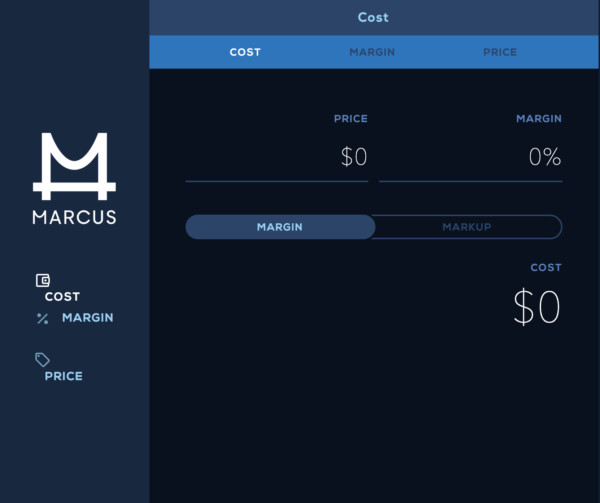Think about the millions of relationships you’ve had throughout your life. Whether you’ve asked someone out on a date, made plans to golf with a friend, or invited a neighbor into your place, eventually it’s fine to make a move. You’ll notice a similar rhythm in your business relationships. Prospects have subtle ways of letting you know that it’s okay to kick it up a notch. You just have to know what to look for. Marcus Lemonis calls this having “Skin in the game.” Someone’s engaging to the point where they’re investing in you. So, if you’re wondering when it’s time to ask for the sale, read on to learn how to spot all the signals that indicate your customers are welcoming your message with open arms.
Nonverbal Tips On Asking For The Sale
1. Signs Your Audience Is Connecting With What You Are Saying
Pay close attention to your clients’ body language. Are they leaning forward? Do they look relaxed? Are they looking you in the eye? Do they appear focused? These are all great signs that they’re metaphorically “leaning in.” You’re advancing the ball and they’re on board. Think of these signals as affirming. But also weigh in signs of resistance. Do they appear closed off? Do they lack enthusiasm? Are you extending opportunities for them to engage and they’re declining? Take everything into account and ask yourself where you net out. Does this conversation feel like the wind is at your back? Or does it feel like it’s blowing strongly in your face? Because if it’s the former, it might be time to ask for the sale.

2. Observe How Your Audience Is Reacting
If your audience isn’t engaging with what you’re saying, that’s okay. You’re still in great shape. You just have to pivot. That was the gist of PepsiCo’s approach when they rolled out what’s called a “Sales Enablement Strategy.” They knew the problems with a stock “one size fits all” presentation in which sales reps were locked into a set path regardless of whether it was working. So, Pepsi threw all that rigidity out the window. Instead, they armed their team with a bunch of different sales sheets that prepared them for a variety of conversations. Then they trained their reps to adjust the conversation according to their audience’s reaction.
It was the ability to read the room and adjust on the fly that allowed Pepsi to jump from the #7 ranked supplier all the way to #1. This was according to a retailer’s survey by Kantar’s, a prominent market research firm.

3. Pay Attention To Whether They’re Taking Notes
When someone’s engaging, they might give you some pretty overt clues as well, like putting pen to paper and taking note of what you have to say. We saw this when Marcus met up with the owners of a company that builds high-end gazebos. Marcus thought their product was incredible, but also had a few concerns. He felt the price was too high, worried that they were buying their materials retail instead of wholesale, and was bothered by the fact that they didn’t have commercial-grade equipment. For some investors, these issues could be a dealbreaker.
But Marcus didn’t disengage. Instead, he dove further in and started to take notes. One of the founders took note of Marcus’ engagement and knew this was a sign that Marcus was trying to make the numbers work. The interest seemed legit. So later, when the owner had a heart-to-heart with Marcus, he felt like it was time to close the deal. Marcus went from taking notes to ultimately giving them an offer. While this partnership didn’t evolve into a long-term arrangement, the owner had read the signals right and took the chance to ask for the sale.
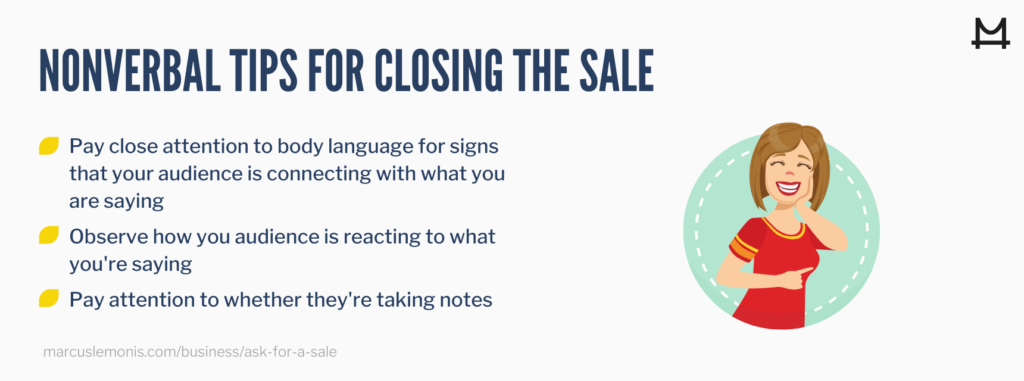

Verbal Cues To Ask For The Sale
1. Your Audience Is Asking A Lot of Questions
Generally speaking, you’re only doing the deep dive on things that grab your interest. So, when your prospect is asking a lot of questions, that’s a pretty reliable sign that they’re engaging. Just make sure your sales team has the answers. One way to do that is through knowledge sharing. That’s how WePay, a leading online payments company, grew their business. Each week they held a company meeting where sales reps had a chance to share that week’s roadblocks.
By raising the visibility of these potholes they allowed the other reps to prepare for them. In other words, once a single salesperson learned a lesson the hard way, the rest of the team didn’t have to. This strategy helped WePay grow so much that they went on a hiring spree and tripled their headcount. Don’t look at questions as friction. Look at them as an opportunity to “wow” someone.
2. They Ask To View Your Product Or Service Multiple Times
Sales can be a high-touch game. In fact, RAIN Group, a sales training firm, explains that it takes an average of eight touches to make a sale. So, if you feel like conversations are dragging out, cheer up. Because you’re probably on the right track. People need a minute to build their comfort level, not just with you, but with what you’re selling. Embrace the slow road. Make the best of these touches by asking some questions of your own. That will help you keep your fingers on the pulse of the conversations, better understand their business problems, and address objections before they’re even made.

3. Your Audience Asks About Customization
When someone asks if you can tweak your offering to meet their needs, that’s because they’re already visualizing themselves using it. That’s great news, but navigate the customization talks with care. As a leader, you’re in the business of making things happen, which is a great quality. But resist the temptation to get caught up in the enthusiasm and overpromise. It’s okay to take a second to make sure you can actually deliver. It’s like Marcus always says, “People respect you more if they get the truth.”
So, don’t be afraid to tell someone that you need to look into it further, or even that your product can’t do something. Even though it might be a dealbreaker on this particular sale, you might’ve earned enough trust to do a ton of business with them next time.

4. They Ask Details About Payment
If they’re asking for the specifics of how to actually give you money, congratulations. It’s time to ask for the sale. They’re interested and just wondering if it’s in their budget. Make sure you’re ready to help them figure that out. Be ready to speak in a knowledgeable way about payment plans and options. It’s like Marcus always says: “Know your numbers.” You might also consider including this information on a sales sheet. Just because it’s time to ask for the sale doesn’t mean they’re ready to answer right then and there.
They might need to sleep on it, discuss it with their team, or ask for a second layer of approval before breaking out the checkbook. Even if you don’t get the “yes” in the moment, you might wake up with one in your inbox.
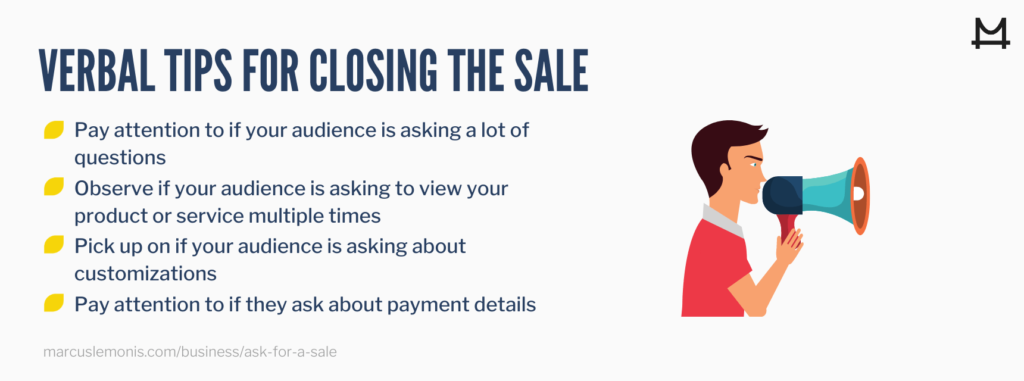

How To Ask For The Sale
1. Allow The Prospect To Try Out The Product Or Service
Once you spot a few of the signs we’ve been over, invite your audience to take your product for a spin. Marcus helped the owners of a family-run chocolate business in Pennsylvania employ this strategy when he got them a meeting with a leading cruise line. The chocolatiers did a great job pitching and connecting, pointing out all of the features and benefits of their products. The execs showed clear interest, so one of the owners offered some free samples. She paid close attention as the executives tried the chocolate and loved it. Then she felt comfortable enough to go for it, asking “how can we earn your business?” The question felt organic because she’d already read the affirming signals, and further, they loved the product. The cruise line execs had some feedback for her and wanted to start small, but she had clearly played her cards right and done enough to escalate the conversation.

2. Keep An Eye On Your Audience
This is cut from the same cloth as the “Sales Enablement Strategy,” but make sure you build some flexibility into your words when you ask for the sale. The chocolate shop owner was very strategic when she used the phrase, “How can we earn your business?” She was basically asking for the sale, but also giving herself an opportunity to field objections. Imagine if she said, “Are you ready to sign a contract?” She’d be putting them in a position where they can either say “yes,” or “no.” Well, what if the “no” was only an inch away? What if you could easily meet their needs as long as you knew more about what their needs were? When you phrase the question like she did, you’re asking for the sale, but also inviting the dialogue that helps you close it.
3. Explain The Cost Of a Missed Opportunity
When you’re thinking about your pitch, tap into two elements: your value-add and the cost of going in a different direction. Let’s say you sell electric cars and a potential customer is thinking about buying something gas-powered. It’s okay to remind them that gas-powered cars come with two significant costs: fuel and damaging the environment. You don’t want to be one of those salespeople who preys on fear, so be careful not to slip into that. But it’s perfectly okay to paint a complete and truthful picture of what happens if they pass on your opportunity.
4. Save The Most Enticing Part For Last
If you’ve ever watched standup comedy, you’re probably familiar with the idea of a “closer.” That’s when the comic saves their best bit for last. You see a similar structure during fireworks displays, concerts — even think about the last line of a movie. People want to end on a high note and go out with a bang. So, think about the order in which you reveal your selling points. You might want to open with something strong, but safe, just to make sure you get people on board. From there, you might reveal your information according to increasing levels of significance. This builds a sense of momentum throughout the pitch. And finally, when you save the best for last, you create a sense of excitement that’s still lingering when it’s time for them to make a decision.
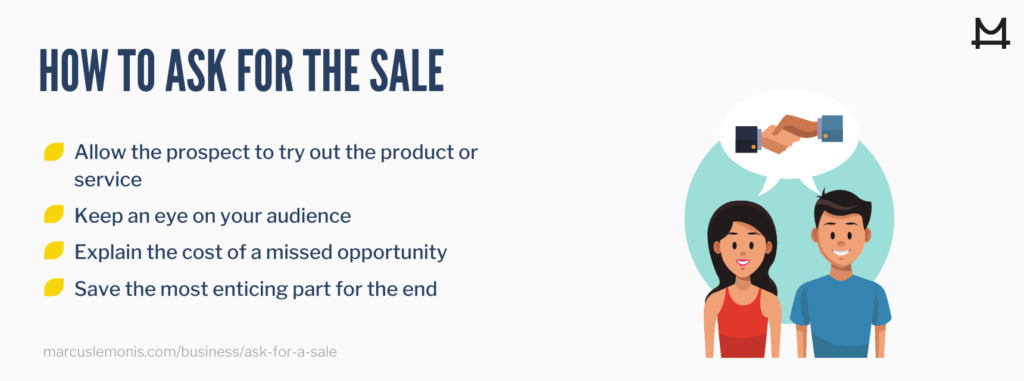
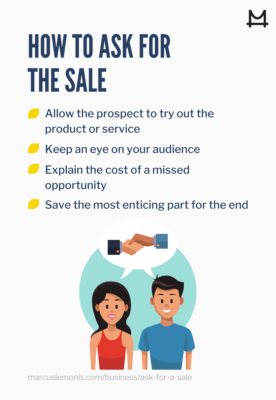
As a consumer, you’ve probably dealt with salespeople of all types. Be the salesperson you’d want to deal with yourself. Look for both verbal and non-verbal cues, but if it seems like a lot to remember, think about it like this: being a salesperson is a lot like being a house guest. Would you show up at a stranger’s house unannounced, in the middle of dinner, and ask to stay the weekend? Or would you build a relationship, read the room, and wait for an opening that felt mutual? People are okay with being sold, but they’ll let you know when. You just have to know what to look for.
- What are some cues that you keep an eye out for during a pitch?
- What are some suggestions from this article that you can implement in your next pitch?
Cachey, J. (August 13, 2019). 3 Fortune 500 companies getting sales enablement right and what you can learn from them. Retrieved from https://www.mediafly.com/3-fortune-500-companies-getting-sales-enablement-right-and-what-you-can-learn-from-them/
Mizne, D. (n.d.). Case study: growing your sales organization beyond the deal. Retrieved from https://www.15five.com/blog/how-to-grow-sales-team-case-study/
Schultz, M. (n.d.). How many touches does it take to make a sale? Retrieved from https://www.rainsalestraining.com/blog/how-many-touches-does-it-take-to-make-a-sale#:~:text=The%20simple%20answer%20is%3A%20more,more%20to%20make%20the%20sale

